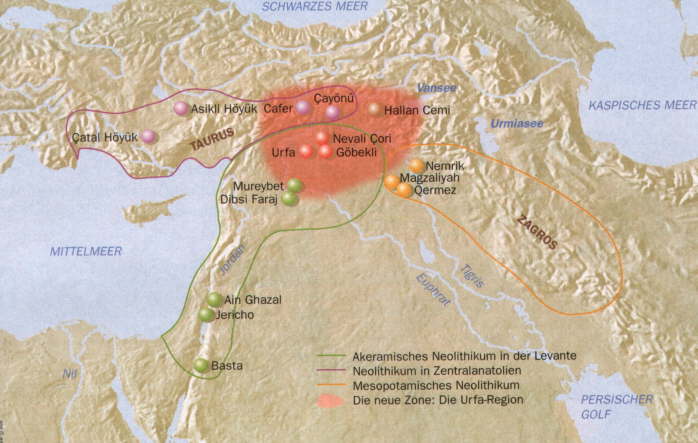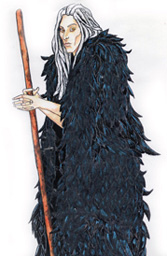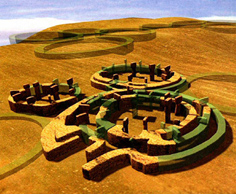| |
![]()
EARTHQUEST
NEWS
Andrew Collins Newsletter Vol. 12 No. 1 (May 2009)
vi.
The Genesis
Secret
 | One book that you might just notice in the top 20 bestseller section of W H Smith (or Barnes and Noble if you are in the USA) is The Genesis Secret by Thomas Knox (HarperCollins, 2009, and see also the website at http://thegenesissecret.com). It is a novel centred around the discovery in southeast Turkey of the pre-Neolithic megalithic complex of Gobeli Tepe, constructed c. 10,000 BC. |
Thomas Knox is the nom-de-plume of British journalist Sean Thomas, who first contacted me back in 2007. He had become interested in Gobekli Tepe, which I have written about extensively since going there in 2004. He wanted to visit the megalithic complex, and so Sue and I gave him instructions on how to get there. A few months later his article on the subject appeared in newspapers worldwide. It highlighted the fact that Dr Klaus Schmidt, the German archaeologist in charge of excavations at the site, had unofficially admitted that the region was most probably the Garden of Eden. This, of course, was the conclusion I had made in my book From the Ashes of Angels, published in 1996, which provides ample evidence that Eden was located where the headwaters of the Tigris and Euphrates rivers arose, close to Lake Van in southeast Turkey (a new theory at this time).
My book appeared four years before the first announcements regarding the discovery of Gobekli Tepe, which is still being uncovered now. What I stated also was that the heretical Jewish work known as the book of Enoch, alluded to Eden, known also as "Paradise" and "Heaven", as being the home of the Watchers, a race of mythical beings often identified as human-like angels. |
Map
of the Near East showing Gobekli Tepe, |
They are credited with having revealed the forbidden arts and sciences of Heaven to mortal kind, causing mankind's fall from divine grace, and his expulsion from the Garden of Eden.
The
Story of the Watchers
In both the book of Genesis (chapter six) and
the book of Enoch, the rebel Watchers are said also to have come upon the Daughters
of Men, i.e. mortal women, who gave birth to giant offspring called Nephilim.
For this transgression against the laws of Heaven, the renegades were incarcerated
and punished by those Watchers who had remained loyal to Heaven. The rebel Watchers'
offspring, the Nephilim (a word meaning "those who fell), were either killed
outright, or were afterwards destroyed in the flood of Noah. Some, however, the
book of Numbers tells us, survived and went on to become the ancestors of giant
races, such as the Anakim and Rapheim.
I wrote that the story of the Watchers
is in fact the memory of a priestly or shamanic elite, a group of highly intelligent
human individuals, that entered the Upper Euphrates region from another part of
the ancient world sometime around the end of the last Ice Age, c. 11,000-10,000
BC. On their arrival in what became known as the land or kingdom of Eden (a term
actually used in the Old Testament), they assumed control of the gradually emerging
agrarian communities, who were tutored in a semi-rural life style centred around
agriculture, metal working and the rearing of animal live stock. More disconcertingly,
these people were made to venerate their superiors, i.e. the Watchers, as living
gods, or immortals.
The precise same region of the Near East, now thought
to be the biblical Garden of Eden, has long been held to be the cradle of civilization.
Here a number of "firsts" occurred at the beginning of the Neolithic
revolution, which began c. 10,000-9000 BC. It was in southeast Turkey, northern
Syria and northern Iraq, for example, that the first domestication of wild grasses
took place, the first fired pottery and baked statues were produced, the first
copper and lead were smelted, the first stone buildings and standing stones were
erected, the first beautification of the eyes took place among woman, the first
drilled beads in ultra hard stone were produced, the first alcohol was brewed
and distilled, etc., etc. In fact, many of the arts and sciences of Heaven that
the Watchers are said to have revealed to mortal kind were all reported first
in this region of the globe, known to archaeologists as Upper Mesopotamia, and
to the people of the region as Kurdistan.
Sean Thomas acknowledges my help
at the beginning of the The Genesis Secret, which follows exactly the same themes
as From the Ashes of Angels (and my later book Gods of Eden, published in 1998),
including the fact that the Watchers and founders of Eden were bird man, i.e.
shamans that wore cloaks of feathers, and that local angel worshipping cults in
Kurdistan, such as the Yezidi, Yaresan and Alevi, preserve some semblance of knowledge
regarding the former existence of the Watchers or angels as the bringers of civilization.
Their leader, they say was Azazel, known also as Melek Taus (or Melek Tawas),
the "Peacock Angel". Azazel is a name given in the book of Enoch for
one of the two leaders of the rebel Watchers (the other being Shemyaza).
It
is an honour for my work to be acknowledged in this manner by Sean Thomas, especially
as The Genesis Secret has become a bestseller (as was From the Ashes of Angels
in 1996). I won't spoil the plot, so will not reveal Sean's conclusions, or indeed
the climax of the book, although I must warn you that it is extremely gory in
places!
A
Clue in Albinism
I am sure people will ask me about some of Sean's
assumptions in his book regarding the origins of the Watchers. All I can say is
that in my opinion accounts of the Watchers from so-called Enochian literature,
the earliest forms of which were found among the Dead Sea Scrolls, tend to suggest
that at least some of their number bore physical traits resembling those of tall
albinos with long, serpentine faces, penetrating eyes, long wiry, white hair and
skin as white as snow but also as red as a rose. It is even suggested that the
Watchers might have used oils in order to protect their sensitive skin from the
affects of direct sunlight, another common trait of albinos.
A
Watcher of Eden | In medical science albinism is the result of a recessive gene that effects only one in every two or more generations of offspring. In other words, if the gene exists in previous generations of a family line then a couple with no albino traits themselves can produce offspring with albino traits. Such recessive genes cannot, in theory, produce whole families of albinos, even though extremely fair features in Caucasians can be classed as a form of mild albinism, and these traits can be passed on from one generation to the next. |
This
said, if in the past, albinism was seen as a special or mystical trait in humans,
whereby (as was the case in parts of Africa in the past) albino children were
set aside at birth, removed from their parents and trained as priests or shamans,
then it is possible that elite groups of shamans could have contained a high proportion
of individuals with such striking characteristics. Today, in various African cultures
albinos are still seen as having magical powers, a belief that has degenerated
in some regions into a macabre trade in albino body parts, which are used in spell
potions by witch doctors, since they are believed to bring about good luck. In
Tanzania in particular, albinos live in fear of being abducted, maimed and killed
in this sick trade, something that has only recently been exposed by the international
news media.
It is possible that groups of shamans, including individuals
with distinctive albino features, were forced to migrate from one part of the
ancient world to another at the end of the last Ice Age due, perhaps, to severe
climatic upheavals (caused perhaps by a comet fragmentation, c. 11,000-10,000
BC, a matter I discuss in two books Gateway to Atlantis, 2000, and the new book
Beneath the Pyramids). If so, then their entry into a foreign territory, such
as Upper Mesopotamia, where the Palaeolithic hunter gatherers might have been,
say, shorter with dark features and more rounded heads, could have led to this
shamanistic group of individuals commanding instant recognition as social and/or
religious leaders with virtual otherworldly qualities. An acceptance of their
assigned rank might have been compounded not simply by their strange appearance
and apparent difference in height, but also by their existing knowledge of life
skills, such as agriculture, metal working and other forms of primitive technology,
such as lapidary, ceramics, stone construction, and the manufacture of drugs and
alcohol, beer in particular. It is thus possible that the Watchers used this situation
to their advantage, perpetuating the belief that they were quite literally divine
beings, the same stance adopted by the first Europeans to encounter native peoples
of the Americas. In this manner the incoming Watchers, as they became known, were
able to more easily control the emerging population of the Near East through fear,
respect and total domination. In this manner, the memory of the Watchers has survived
in ancient texts, such as the book of Enoch, as the sudden appearance of a race
or gods, angels or immortals that came out of nowhere and revealed to mortal kind
the forbidden arts and science of Heaven.
It is remotely possible that
the Watchers, as flesh and blood individuals with albino traits, represented the
last strains of a former branch of humanity, perhaps an offshoot of the Neanderthals
or even Homo Heidelbergensis, who were the precursors of Homo sapien sapiens.
Yet such an idea must remain speculation until we find anatomical evidence for
the former existence of the Watchers, whose descendents, I have long suspected,
existed through until the second millennium BC, when the last of their kind died
out. This evidence will one day, hopefully, be found, yet until then the origins
of the Watchers must remain a mystery.
Watcher
Origins on the Nile
So where did the Watchers as the bringers of civilization
come from in the first place? I have always maintained that prior to their appearance
in Upper Mesopotamia, the original Garden of Eden, sometime around the end of
the last Ice Age, the ancestors of the Watchers thrived among the advanced Palaeolithic
communities of Upper Egypt. If so, then perhaps they were the social and religious
motivators behind Palaeolithic groups such as the Isnan and Qadan, who thrived
c. 13,500-10,500 BC, and possessed a superior form of microblade technology, unequalled
anywhere else in either Europe or Western Asia. The Isnan and Qadan also lived
in organized settlements, unlike anything else existing in the ancient world until
the coming of the earliest Pre-Pottery Neolithic communities of Upper Mesopotamia,
the builders of Gobekli Tepe, and would seem even to have developed a proto form
of agriculture, the first anywhere in the world.
Did the ancestors of the Watchers leave Upper Egypt for new territories at the end of the last Ice Age, c. 10,500 BC, when the advanced life style of the Isnan and Qadan vanishes virtually over night? Was such a move prompted by climatic changes, perhaps instigated by some kind of global cataclysm, such as the aforementioned comet fragmentation, a subject much debated among scientists today?Others have seen fit to explain the sudden appearance of the Watchers as the bringers of civilization in Upper Mesopotamia around the end of the last Ice Age in different ways. |
Reconstruction of Gobekli Tepe (Pic credit: DAI/German Archaeological Institute) |
For instance, anthropological writer and physician Stephen Oppenheimer in his essential book East in the East (1998) saw the original homeland of the long-faced founders of civilization as the drowned regions of Southeast Asia. Some have seen the Watchers as having come down from the cold wastes of Siberia, where albinism might have thrived in low temperatures, giving rise to legends of the frost giants (or Northmen) of Nefilheim. Still others see the Watchers as having come from outer space, after the sensationalist books of Zecharia Sitchin, a theory that for me simply doesn't make good sense.
The
Watchmen of Gobekli Tepe
Gobekli Tepe (Pic Credit: Andrew Collins) | That the Watchers might have been behind the creation of Gobekli Tepe, now officially the "oldest temple in the world", and the oldest known megalithic (i.e. great stone) complex anywhere, is almost beyond question, as is their role in the genesis of civilization. As to where their advanced knowledge and wisdom might have come from, the answer is, I suspect, otherworldly journeys using shamanic flight, something clearly indicated by the astral nature of the art found at these proto-Neolithic cult centres, which is predominantly avian in nature. |
Yet
in addition to reliefs and carvings of birds, including the vulture and ostrich,
many other examples of reliefs and sculptures have been found at Gobekli Tepe.
These show animals, insects, spiders, reptiles, hybrids and humans, which head
excavator Dr. Klaus Schmidt from the DAI (German Archaeological Institute) sees
in terms of the "watchman (sic) of the period", a term he uses for those
responsible for the construction of these strange, dark monuments of stone. The
word "watchman" is so close to "Watcher" that this cannot
be coincidence.
That Gobekli Tepe was constructed a full 7,000 years before
either the Great Pyramid or Stonehenge is mind numbing in its implications for
the history of human capability. More disturbing still is that the descendents
of those Watchmen, or Watchers, who built Gobekli Tepe went on to construct further
megalithic complexes. As these went on they became cruder and cruder, until the
early Neolithic peoples of southeast Turkey were simply erecting uncut standing
stones or slabs either in circles or in lines. Much of the finesse of Gobekli
Tepe and its contemporaries (Karahan Tepe and Nevali Cori, for instance) was lost,
tending to suggest that these people were losing the impetus to create more complex
structures. Despite this, we can see here the foundation of the megalithic culture,
who then spread, c. 7000-5000 BC, from Upper Mesopotamia carrying with them the
technologies and sciences of the Neolithic age, including an understanding of
plant domestication in order that the world could settle into a more sedentary
life style, away from its previous course of constant hunter-gathering.
| Yet it is clear that those who first emerged on the scene in southeast Turkey, c. 10,000 BC, and built Gobekli Tepe, were the ones who possessed the advanced capabilities that kick-started the Neolithic revolution. This is the story told in veiled form within the book of Enoch, unravelled by me in From the Ashes of Angels and Gods of Eden, and novelised in The Genesis Secret by Sean Thomas, writing as Thom Knox. His book is well recommended, although watch the gore, which is quite gruesome in places! |
![]()
| |




